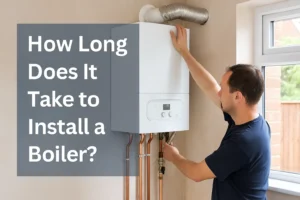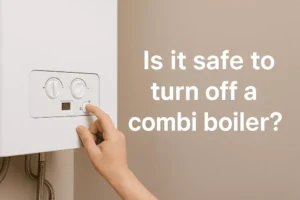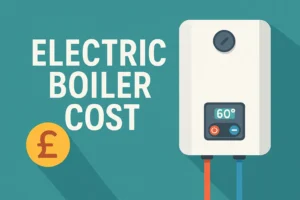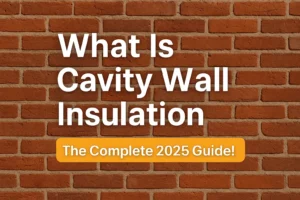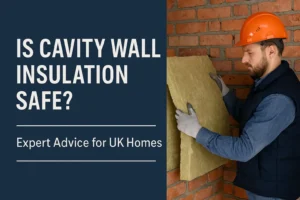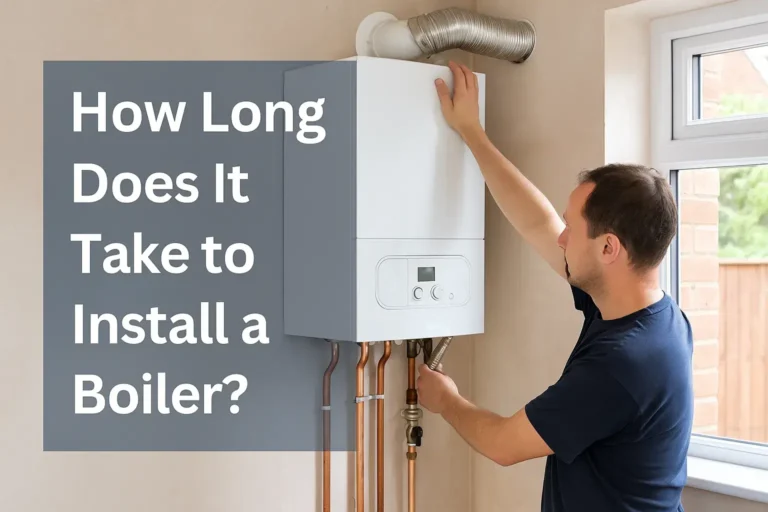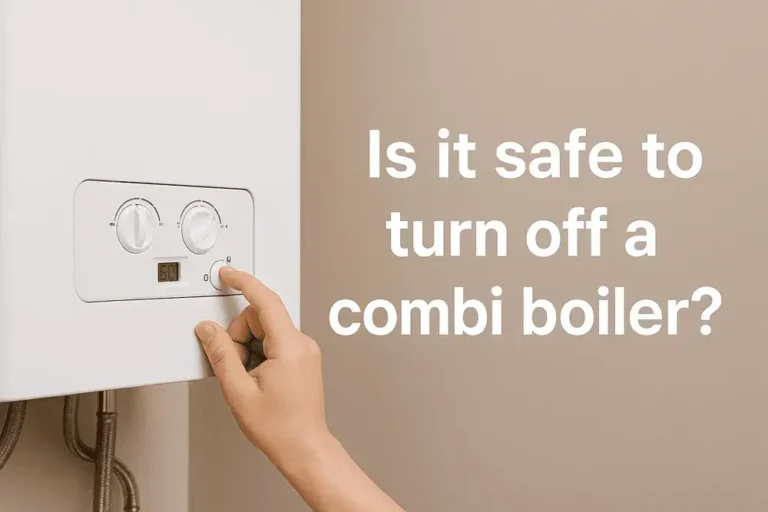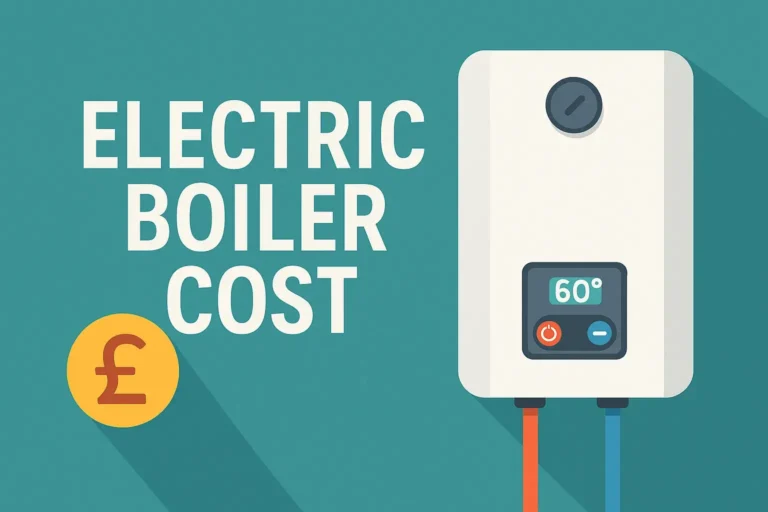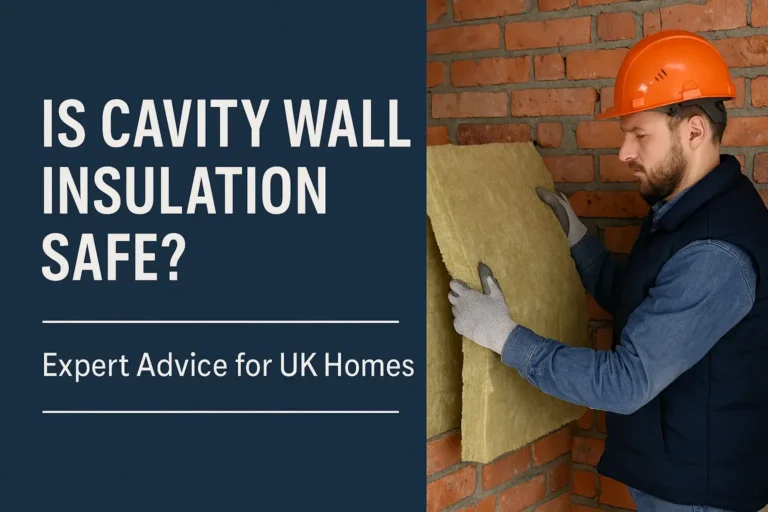Cavity wall insulation is one of the most effective and affordable ways to reduce energy bills, improve comfort, and lower carbon emissions in UK homes. As we move further into 2025, with energy prices remaining high and government incentives like the ECO4 and GBIS schemes still available, the importance of properly insulating cavity walls has never been greater.
Table of Contents
ToggleIf you’re a UK homeowner or private landlord, this guide will walk you through everything you need to know from understanding how cavity wall insulation works to checking eligibility for free grants under the latest government-backed initiatives.
We’ve written this guide with clarity, accuracy, and real-world experience, drawing on industry standards, regulatory guidance, and proven on-site practices. Whether you’re retrofitting a 1930s semi-detached home or managing multiple rental properties, this guide will help you make confident, informed decisions about insulation.
🧱 1. What Is Cavity Wall Insulation?
Cavity wall insulation is an energy efficiency measure that fills the air gap between the two layers of brickwork in external walls. This air gap known as a cavity was originally intended to reduce moisture penetration but can also lead to significant heat loss if left uninsulated.
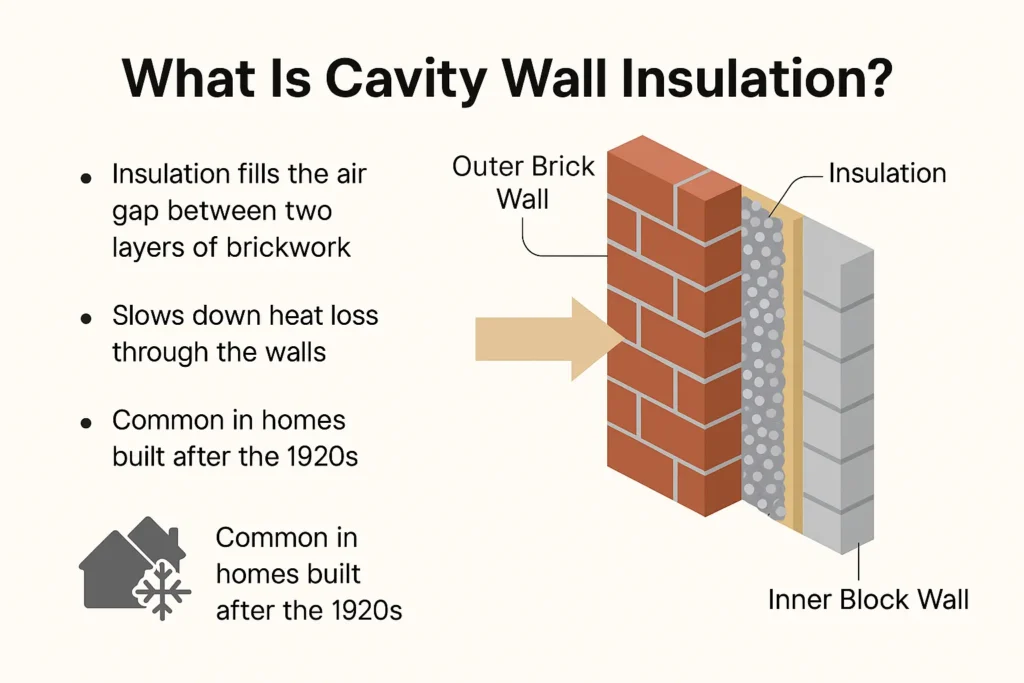
In many UK homes built after the 1920s, walls were constructed with this cavity. By injecting approved insulation materials into that space, installers create a thermal barrier that slows down heat escaping from the property especially through external walls, which typically account for around 35% of total heat loss.
🏠 What Are Cavity Walls?
A cavity wall consists of two separate walls (or ‘leaves’) an outer layer of brick and an inner layer of block or brick separated by a gap typically between 50mm and 100mm wide.
- Homes built pre-1920s often have solid walls with no cavity.
- Homes built between 1920 and the 1990s usually have cavity walls, but many remain uninsulated.
- Post-1990 buildings generally have insulated cavity walls as standard.
🧊 How Cavity Wall Insulation Works
Installers drill small holes in the external brickwork, then inject insulating material such as:
- EPS polystyrene beads (most common in 2025)
- Mineral wool fibre
- Urea-formaldehyde foam (less common today)
The insulation traps air and reduces conduction, preventing warmth from escaping through the walls in winter and limiting heat ingress in summer. The holes are then sealed with mortar to match the existing brickwork.
🔎 Suitable Property Types
Cavity wall insulation is suitable for:
- Detached, semi-detached, and terraced houses
- Bungalows and some flats
- Homes with cavity wall construction and accessible external walls
It is not suitable for homes with solid walls, timber-framed construction, or where the cavity is contaminated or too narrow. A professional retrofit assessment is always required to confirm suitability.
🔍 2. How to Tell If You Have Cavity Wall Insulation
Before applying for a grant or scheduling an installation, it’s important to know whether your home already has cavity wall insulation and if so, whether it’s performing effectively. There are several ways to check, ranging from simple visual inspections to professional retrofit assessments.
🧱 1. Look for Injection Holes in the Brickwork
The most obvious sign that your walls are insulated is a pattern of small, evenly spaced filled holes in the external brickwork. These holes are where insulation was previously injected and then sealed with mortar. You’ll often spot them on side or rear elevations, especially on older installations.
📄 2. Check Your EPC (Energy Performance Certificate)
If you bought or rented the property recently, it likely has an EPC report that shows whether the walls are insulated. Look under the “Walls” section of your EPC for entries such as:
- “Cavity wall – filled cavity”
- “Cavity wall – no insulation (assumed)”
- “Cavity wall – insulation (assumed)”
You can also search for your EPC online via the UK Government’s EPC Register.
🧰 3. Book a Professional Survey
If you’re still unsure, the best route is to book a free cavity wall insulation survey through a qualified retrofit assessor. They may use borescopes, thermal imaging cameras, or drill inspections to determine if the cavity is filled and if it was installed to standard.
🧊 4. Look for Cold Spots or Mould (if insulation has failed)
If your property is insulated but you’re still experiencing cold walls or damp patches, the insulation may have settled or become damp. This can lead to reduced performance and even internal condensation.
💬 Pro Tip:
Some homes, especially those insulated before 2005, may have incomplete or poorly installed insulation. If your EPC is outdated or unclear, a retrofit assessment under PAS 2035 can confirm insulation quality and whether replacement or extraction is necessary.
💰 3. What Are the Benefits of Cavity Wall Insulation?
Cavity wall insulation is one of the most cost-effective energy efficiency upgrades for UK homes delivering immediate and long-term advantages. Whether you’re motivated by cutting bills, improving comfort, or reducing your carbon footprint, the benefits are tangible and measurable.
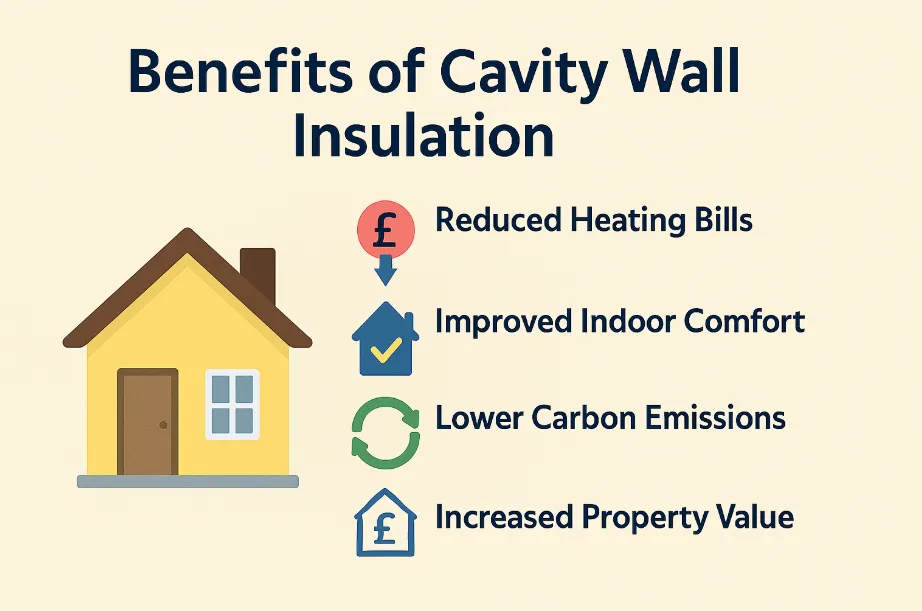
🔥 1. Reduced Heating Bills
Insulating your cavity walls helps retain heat inside your home during colder months. On average, a properly insulated property can save £285 to £500 per year on heating bills, depending on the property size and energy usage (Energy Saving Trust, 2025).
🧊 2. Improved Indoor Comfort
Insulated cavity walls lead to more consistent indoor temperatures, fewer cold spots, and a noticeable reduction in draughts. This is especially beneficial for homes with large external wall exposure or poor ventilation.
♻️ 3. Lower Carbon Emissions
By reducing the amount of energy needed to heat your home, cavity wall insulation helps decrease your household’s carbon footprint. This supports the UK’s goal of net-zero emissions by 2050 and may help your home achieve a better EPC rating.
🏠 4. Increased Property Value & Appeal
Energy-efficient homes are increasingly attractive to buyers and tenants. A well-insulated home with a high EPC rating may achieve a higher resale value or reduced time on the market, especially when energy costs are high.
💷 5. Access to Free Government Grants
In 2025, many households qualify for free cavity wall insulation under the ECO4 and GBIS schemes. These schemes are designed to reduce fuel poverty and improve UK housing stock.
🛠 4. Installation Process: What to Expect
Installing cavity wall insulation is a straightforward process when handled by a qualified team. It typically takes less than a day and causes minimal disruption to the property. Yet, behind this simplicity lies a carefully managed procedure designed to ensure performance, safety, and compliance with national retrofit standards.
🔎 Pre-Installation: Retrofit Assessment
Every installation under the ECO4 or GBIS scheme must begin with a PAS 2035-compliant retrofit assessment. This survey is critical to determine if the property is suitable for insulation, and includes:
- Confirming that walls are cavity construction (not solid)
- Measuring cavity width (typically 50mm to 100mm)
- Checking for signs of damp, debris, or wall tie corrosion
- Assessing the building’s exposure level (e.g. wind-driven rain zones)
- Verifying the condition of mortar joints and brickwork
Homes that pass this assessment move forward to the installation stage. If concerns are found, remedial works or alternate measures may be recommended.
🧱 Step 1: Drilling Access Holes
Specialist installers drill a series of 22mm holes in the external mortar joints of the property. These are spaced evenly in a grid pattern, typically 1 metre apart horizontally and 1.5 metres vertically, ensuring even distribution of insulation.
This stage is completed with precision to avoid damaging the structural integrity or appearance of the wall.
📦 Step 2: Injecting Insulation Material
Using a calibrated pressurised system, technicians inject insulation into the cavity. The most commonly used materials in 2025 are:
- Expanded polystyrene (EPS) beads – lightweight, moisture-resistant, and durable
- Mineral wool fibres – fire-resistant and dense
- Foam (rare) – now used mainly in special cases
Installers continuously monitor the pressure to avoid overfilling or leaving voids.
🧱 Step 3: Sealing and Blending
Once the cavity is filled, all drilled holes are sealed using a colour-matched mortar. This restores the original appearance of the external wall and ensures no thermal or moisture bridging occurs.
The finish is subtle, and often becomes barely visible over time.
✅ Step 4: Quality Checks and Guarantees
Post-installation, the site is inspected for:
- Full and even cavity fill
- Clean-up and reinstatement
- Safe sealing of all access points
Most installations are backed by a 25-year CIGA guarantee (Cavity Insulation Guarantee Agency), providing homeowners with long-term assurance against material failure or poor workmanship.
⏱ Duration and Disruption
- Typical installation time: 2–4 hours for a semi-detached home
- No need to vacate the property
- Work is carried out externally
- No internal decoration or replastering required
This makes cavity wall insulation one of the least invasive retrofit upgrades available with immediate thermal benefits.
🛡 Compliance and Accreditation
To ensure safety and performance, all work must be carried out by installers:
- Certified under PAS 2030
- Registered with TrustMark
- Audited under the ECO4 scheme
- Using BBA-approved materials
These safeguards ensure that every project aligns with UK national standards and reduces the risk of future damp, settlement, or insulation failure.
5. Is Cavity Wall Insulation Safe?
When properly installed by accredited professionals, cavity wall insulation is safe, effective, and beneficial to both property performance and occupant wellbeing. However, like any building measure, its safety depends on appropriate assessment, correct installation, and post-installation care.
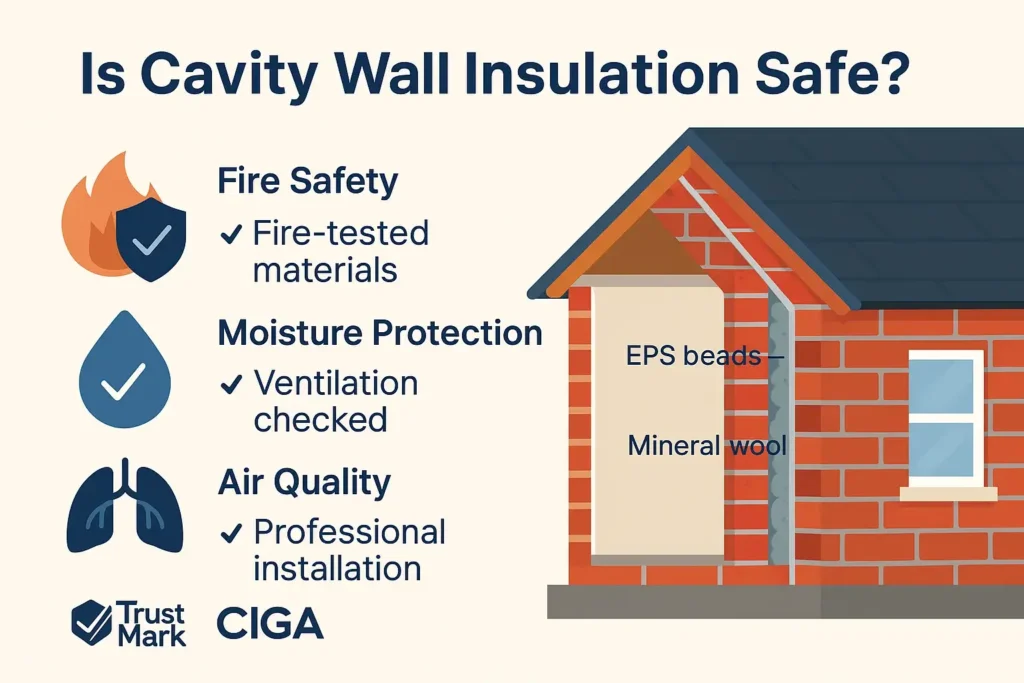
🔥 Fire Safety
All insulation materials used under government-backed schemes must meet UK fire safety regulations, including BS 8414 and Building Regulations Part B. The most commonly used materials such as expanded polystyrene beads and mineral wool are either fire-resistant or have fire-retardant additives.
While some early-generation foams had higher combustibility, these are now largely phased out in favour of safer alternatives. Modern installations focus on low-risk, non-toxic, fire-tested materials.
💧 Moisture & Damp Concerns
The most common concern around cavity wall insulation is its potential to cause or worsen dampness. In reality, insulation itself doesn’t cause damp but if installed incorrectly, in an unsuitable property, or without addressing pre-existing defects, moisture issues can arise.
To ensure safety and long-term performance:
- A PAS 2035 retrofit assessment must be carried out first.
- Cavities must be clean and dry, free of debris or wall-tie corrosion.
- Properties in exposed or high-rainfall areas should be risk assessed using wind-driven rain maps.
- If internal moisture risk is present, ventilation upgrades should be considered alongside insulation.
When these steps are followed, cavity wall insulation can actually reduce damp risk by eliminating cold surfaces where condensation forms.
🫁 Health Considerations
Cavity wall insulation materials used in 2025 are:
- Formaldehyde-free (no VOC off-gassing from foam products)
- Non-toxic and non-irritant when fully sealed in the cavity
- Safe for households with children, pets, or respiratory conditions
As part of PAS 2035-compliant installations, occupants are also assessed for vulnerability to indoor air quality issues, and the property is checked for suitable ventilation pathways (such as trickle vents or mechanical systems).
🏠 Structural Integrity
Insulation does not compromise the structural performance of cavity walls. On the contrary, it can improve thermal balance, reducing thermal stress on wall materials over time. However, it’s essential that:
- Wall-ties are not corroded
- Brickwork is in good condition
- No bridging occurs across the cavity
This is why trained retrofit coordinators must sign off the installation.
✅ Summary
Cavity wall insulation is safe when:
- The property is suitable
- The installer is TrustMark registered
- The process follows PAS 2030/2035 standards
- Ventilation, moisture, and structure are assessed holistically
When these standards are met, insulation not only improves comfort and efficiency, but also contributes to a healthier, safer home.
⏳ 6. How Long Does Cavity Wall Insulation Last?
When installed correctly and in a suitable property, cavity wall insulation can last the entire lifetime of the building typically 25 to 40 years or more. In most cases, it remains effective without the need for maintenance, as it is sealed within the wall cavity, protected from weathering and physical damage.
However, the longevity of insulation depends on three key factors: material used, installation quality, and property condition.
📦 1. Material Durability
Modern insulation materials are designed for long-term performance:
- Expanded Polystyrene (EPS) Beads
These are the most durable and moisture-resistant option used in 2025. They are non-absorbent, settle minimally, and are resistant to rot or mould. EPS insulation can last well over 40 years if properly installed. - Mineral Wool Fibre
This dense, fire-resistant material also performs well over decades. It is less prone to displacement but can retain moisture if exposed to prolonged damp. Expected lifespan: 30–40 years. - Urea-Formaldehyde Foam (Older Installations)
Less commonly used today, older foam installations from the 1980s–90s can degrade, shrink, or become brittle. If your home has this type of insulation, a retrofit assessment is advised to check its condition.
🛠 2. Installation Quality
Poorly installed insulation is more likely to underperform or fail. Common issues include:
- Incomplete filling (leaving cold spots)
- Voids or blockages due to cavity debris
- Over-pressurisation causing wall damage
- Improper sealing of injection holes
This is why insulation installed today must meet PAS 2030 standards, include a pre-installation retrofit assessment, and be carried out by TrustMark-registered contractors.
🧱 3. Property Suitability
Insulation will only last as long as the building remains structurally sound. Key property-related risks include:
- Wall-tie failure (can create movement in the cavity)
- Penetrating damp due to cracks or damaged render
- Wind-driven rain in exposed locations
- Ground moisture ingress near the damp-proof course
If any of these conditions are present, insulation can become damp or displaced, reducing effectiveness. That’s why post-installation performance depends on ongoing property maintenance and proper risk assessment before installation.
🔄 Can Cavity Wall Insulation Be Replaced?
Yes. If insulation becomes damp, compacted, or degrades over time, it can be extracted and replaced. This process involves vacuum removal of old material, drying the cavity, and re-insulating often using modern EPS beads.
Replacement is typically only necessary in homes with faulty early installations, unresolved damp issues, or where the cavity was not properly cleaned before insulation.
📜 Guarantees and Lifespan Coverage
Most modern cavity wall insulation projects come with a 25-year CIGA guarantee, offering coverage against material failure and workmanship issues. While this doesn’t mean the insulation stops working after 25 years, it ensures protection and recourse during its most critical performance window.
✅ Summary
- EPS and mineral wool cavity wall insulation can last 30–40+ years
- Lifespan is maximised by professional installation, suitable property conditions, and regular maintenance
- If installed under ECO4 or GBIS, insulation includes long-term guarantees and compliance with UK building standards
💷 7. Is Cavity Wall Insulation Worth It in 2025?
For many UK homeowners, the decision to install cavity wall insulation in 2025 comes down to one question: is it worth the investment?
The answer for most properties is a resounding yes.
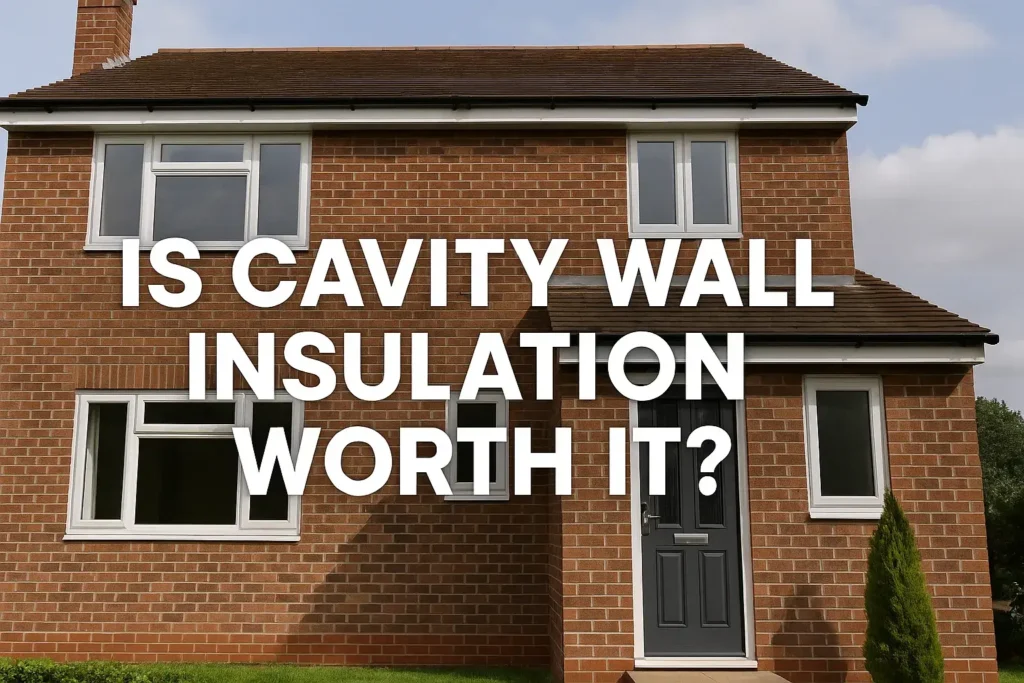
With rising energy costs, government-funded grants, and increased focus on energy efficiency, cavity wall insulation offers some of the highest returns of any retrofit measure.
💸 Cost vs. Savings
- A typical cavity wall insulation installation costs £600–£1,200 for an average-sized home.
- Under the ECO4 and GBIS schemes, many households pay nothing at all.
- Energy bill savings can reach £285–£500 per year depending on property size and energy usage (Energy Saving Trust, 2025).
This means that even if you’re paying privately, payback is often under 3 years and after that, you continue to save for decades.
🌡 Thermal Performance
Properly installed insulation can reduce heat loss through walls by up to 35%. This leads to:
- Fewer cold spots
- More stable indoor temperatures
- Lower reliance on central heating
In homes with exposed external walls or uninsulated lofts, cavity wall insulation often delivers immediate comfort improvements.
🏠 Property Value and EPC Improvement
Energy-efficient homes are increasingly desirable in the housing market. Improving your Energy Performance Certificate (EPC) rating can:
- Enhance your property’s resale value
- Appeal to eco-conscious buyers and tenants
- Futureproof against potential regulations requiring higher energy performance in rental properties
In many cases, cavity wall insulation alone can raise a home’s EPC by one or two bands.
♻️ Environmental Impact
Every insulated home helps reduce pressure on the national grid and cuts household carbon emissions by hundreds of kilograms annually. For eco-minded homeowners, it’s one of the easiest ways to contribute to UK Net Zero 2050 goals.
It also complements other upgrades like solar panels, loft insulation, and air source heat pumps creating a whole-house approach to retrofit efficiency.
🧾 Funded Under ECO4 and GBIS
Perhaps the strongest reason why cavity wall insulation is worth it in 2025 is the government support available:
- Homeowners receiving benefits or living in low EPC homes often qualify for 100% grant funding
- No repayments, no upfront cost
- Supported by TrustMark and CIGA-backed installers
This means that the return is not just financial it’s a risk-free opportunity to improve your home’s comfort, sustainability, and market value.
✅ Final Verdict
Cavity wall insulation is absolutely worth it in 2025 if:
- Your home has uninsulated cavity walls
- You want to cut heating bills and carbon emissions
- You qualify for free or subsidised installation
- You care about indoor comfort, future energy prices, or property value
It remains one of the quickest, cheapest, and most effective ways to retrofit a home with long-lasting benefits and little to no downside when properly assessed.
🏛 8. Government Grants and Free Cavity Wall Insulation (2025)
In 2025, thousands of UK households are eligible to receive free cavity wall insulation through government-backed schemes. These grants are designed to reduce energy bills, tackle fuel poverty, and cut national carbon emissions all while helping homeowners and landlords upgrade their properties at no cost.
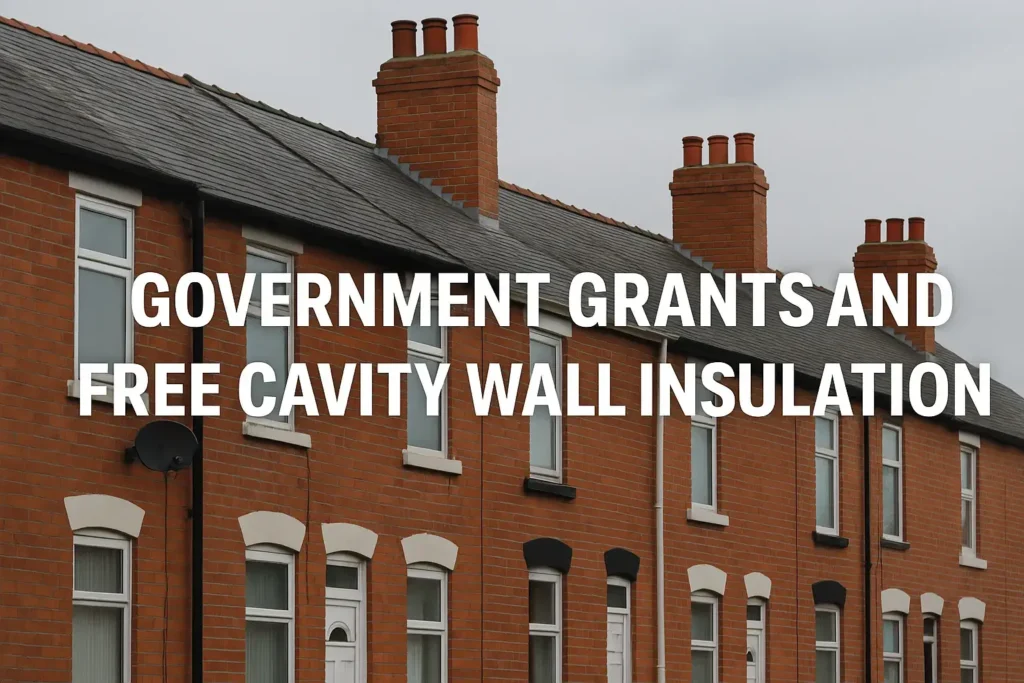
If your home qualifies, you could save £600–£1,200 in installation costs, while enjoying the long-term benefits of better thermal efficiency and lower heating bills.
🎯 Which Schemes Fund Cavity Wall Insulation?
1. ECO4 (Energy Company Obligation)
The ECO4 scheme is a government-mandated initiative requiring energy suppliers to fund energy efficiency improvements in eligible homes. Under ECO4:
- Cavity wall insulation is fully funded for qualifying households
- A whole-house assessment is required under PAS 2035
- Measures may also include loft insulation, first-time central heating, and air source heat pumps
- Available across England, Scotland, and Wales
Eligibility is based on:
- Receipt of means-tested benefits (e.g. Universal Credit, Pension Credit)
- Low EPC rating (typically D, E, F, or G)
- Property suitability for retrofit upgrades
2. GBIS (Great British Insulation Scheme)
The GBIS, formerly ECO+ or “Help to Heat,” expands insulation grants to households that don’t receive benefits but still need support.
You may qualify for GBIS funding if:
- Your home is in Council Tax band A–D (England) or A–E (Scotland and Wales)
- Your EPC rating is D or below
- Your walls are suitable for cavity insulation
GBIS is ideal for working families, retired couples, or anyone who doesn’t qualify under ECO4 but lives in an inefficient home.
🧾 What Does the Grant Cover?
Both ECO4 and GBIS schemes cover:
- Full cost of materials and labour
- Retrofit assessments and coordination under PAS 2035
- Ventilation upgrades where required
- Quality assurance through TrustMark and CIGA
There are no loans or repayments. The work is funded by energy suppliers and fully guaranteed.
🏠 How Do I Apply?
To find out if you’re eligible, simply book a free grant survey or complete an online eligibility check. The process includes:
- Verifying your benefit status or Council Tax band
- Checking your EPC rating (if available)
- Scheduling a retrofit assessment
- Coordinating grant paperwork and installer assignment
From start to finish, the process is handled for you, with no hidden fees or commitments.
🔐 Is It Trustworthy?
Yes. These schemes are government-backed and regulated:
- All work must comply with PAS 2030:2019 installation standards
- All installers must be TrustMark-registered
- Projects are protected by a 25-year CIGA guarantee
Avoid cold callers and non-registered companies. Always apply through a certified installer or verified partner.
💡 Why You Should Act Now
- Funding is limited especially under GBIS
- Delaying could result in higher winter heating costs
- The survey and application process takes just a few days
- Future policy changes may restrict eligibility further
Taking action in 2025 means locking in free upgrades before grant budgets reduce or your property EPC improves past the qualifying threshold.
✅ Summary
You could receive free cavity wall insulation in 2025 through:
- ECO4 for benefit claimants and low-income households
- GBIS for low-EPC homes in lower council tax bands
- Full funding, no repayments, no hassle
If your home is cold, damp-prone, or expensive to heat, now is the time to book a free grant assessment and start saving.
📞 9. Next Steps: Book Your Free Survey Today
By now, you understand the benefits of cavity wall insulation, how it works, who qualifies for government grants, and why it’s worth investing in during 2025. The only step left is to take action and it starts with a free, no-obligation survey.
🧭 What Does the Free Survey Include?
Your cavity wall insulation journey begins with a fully funded assessment by a certified retrofit assessor. The survey includes:
- A property suitability check (cavity type, wall condition, damp risk)
- EPC evaluation and Council Tax band confirmation
- A full PAS 2035-compliant whole-house assessment
- Recommendations for additional upgrades if applicable (loft insulation, ventilation, etc.)
The survey is completely free under the ECO4 or GBIS schemes. There’s no upfront cost and no hidden fees.
🧑🔧 Who Will Carry Out the Work?
All installations are:
- Delivered by TrustMark-registered contractors
- Installed to PAS 2030:2019 standards
- Covered by a 25-year CIGA guarantee
- Coordinated through qualified Retrofit Coordinators
You’ll receive full documentation, photographic evidence of the installation, and compliance certificates upon completion.
⏱ How Long Does It Take?
- Survey booking: usually within 48 hours
- Assessment visit: 30 to 60 minutes
- Installation: 2 to 4 hours on-site
- Paperwork and funding: handled for you
This is one of the fastest and least disruptive upgrades you can make to your home with benefits that last for decades.
🚀 Why Act Now?
- Funding is limited and demand is increasing
- Energy bills remain high delaying means overspending this winter
- EPC improvements may disqualify you later
- The sooner you act, the sooner you save
Don’t wait until grant funding runs out or your home becomes ineligible. The best time to insulate is before the heating season starts.
🟢 Ready to Start?
Click below to:
- Check your eligibility instantly
- Book a free survey
- Speak to an energy advisor for guidance
Check If You Qualify For FREE Cavity Wall Insulation
Your warmer, more energy-efficient home is just a few clicks away.
Frequently Asked Questions
Can I get cavity wall insulation for free?
Yes. Most UK households qualify for free cavity wall insulation through the ECO4 or GBIS schemes. Eligibility depends on your EPC rating, Council Tax band, and whether you receive certain benefits. Use our free eligibility checker to find out in minutes.
Does cavity wall insulation cause damp?
Not when installed properly. Issues occur only when insulation is fitted in unsuitable walls (e.g. damp, narrow, or debris-filled cavities). A PAS 2035 retrofit assessment is always required to confirm that your home is safe for insulation.
How long does cavity wall insulation last?
Modern insulation like EPS beads or mineral wool can last 30–40 years or more. Installations done under ECO4 are guaranteed for 25 years by CIGA (Cavity Insulation Guarantee Agency).
How do I know if my home already has cavity wall insulation?
Look for drill holes in the brickwork, check your EPC report, or book a professional survey. Older installations (pre-2005) may be incomplete or failing, especially foam types.
How long does it take to install cavity wall insulation?
Typically just 2–4 hours for a standard property. The work is done from outside, with no disruption inside the home.
Will cavity wall insulation improve my EPC rating?
Yes. Cavity wall insulation can raise your home’s EPC rating by 1–2 bands, depending on your current energy efficiency. This can also improve property value and lettability.
Is cavity wall insulation safe?
Absolutely. Modern materials are fire-tested, non-toxic, and installed by qualified professionals under TrustMark standards. The insulation is sealed within the cavity and poses no health risk when correctly fitted.
What happens if my cavity wall insulation fails?
It can be extracted and replaced. This typically applies to older foam installations. Today’s EPS bead systems are durable, drainable, and highly resistant to failure.
🏁 Conclusion: Make 2025 the Year You Insulate Smarter
Cavity wall insulation isn’t just a smart upgrade it’s a proven solution that pays you back in comfort, savings, and long-term peace of mind. With government grants like ECO4 and GBIS, thousands of UK homeowners are getting this work done for free, transforming their homes into warmer, more efficient spaces.
If your property has uninsulated cavity walls, the opportunity to lock in free insulation with a 25-year guarantee is here but it won’t last forever. Funding is limited, and delays could mean another cold winter and rising bills.
With benefits that include:
- Lower heating costs
- Improved indoor comfort
- A higher EPC rating
- Reduced carbon emissions
- Enhanced property value
…there’s never been a better time to act.
Take the next step today by booking a free grant assessment or using our quick eligibility checker.
Your future self and your heating bill will thank you.


